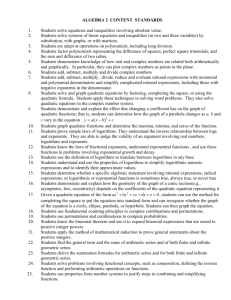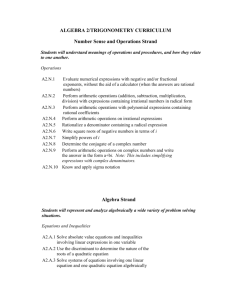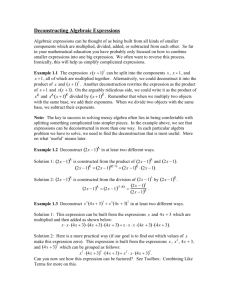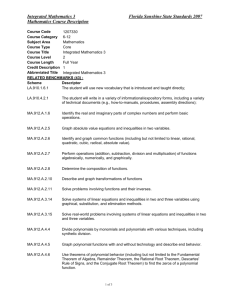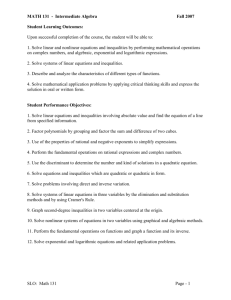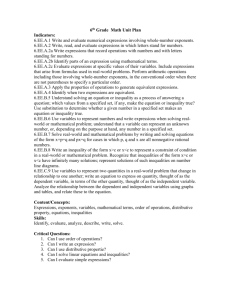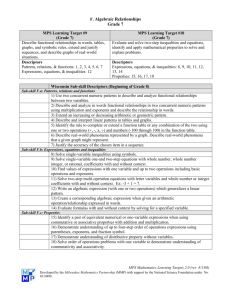Performance Indicators A1-A35
advertisement
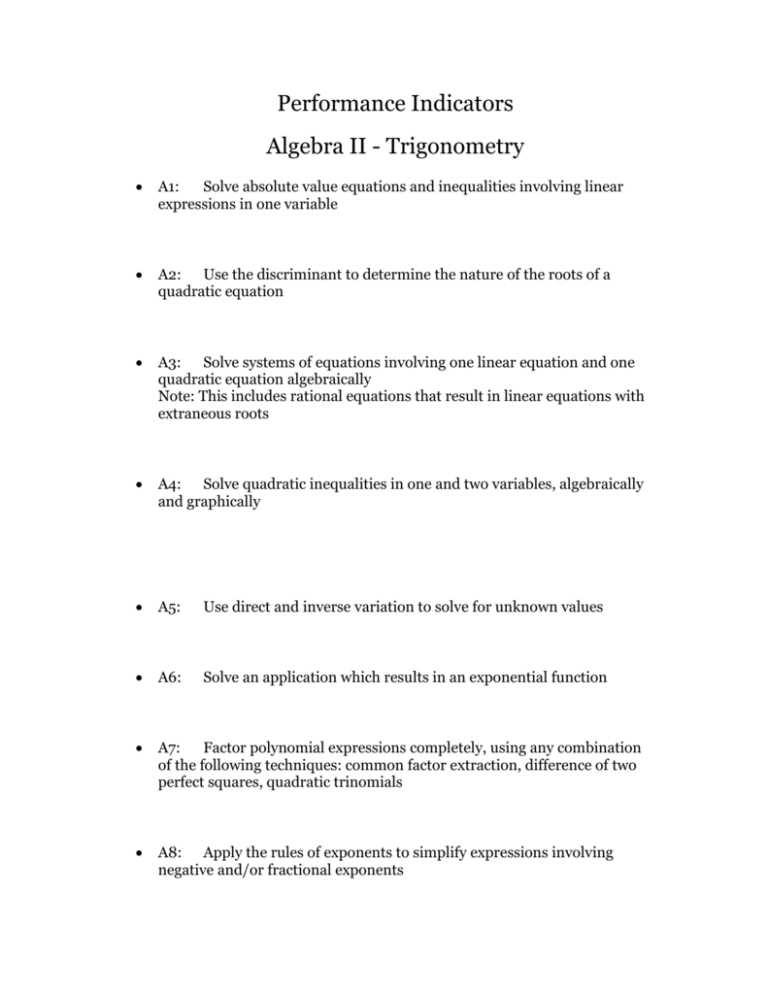
Performance Indicators Algebra II - Trigonometry A1: Solve absolute value equations and inequalities involving linear expressions in one variable A2: Use the discriminant to determine the nature of the roots of a quadratic equation A3: Solve systems of equations involving one linear equation and one quadratic equation algebraically Note: This includes rational equations that result in linear equations with extraneous roots A4: Solve quadratic inequalities in one and two variables, algebraically and graphically A5: Use direct and inverse variation to solve for unknown values A6: Solve an application which results in an exponential function A7: Factor polynomial expressions completely, using any combination of the following techniques: common factor extraction, difference of two perfect squares, quadratic trinomials A8: Apply the rules of exponents to simplify expressions involving negative and/or fractional exponents A9: Rewrite algebraic expressions that contain negative exponents using only positive exponents A10: Rewrite algebraic expressions with fractional exponents as radical expressions A11: Rewrite algebraic expressions in radical form as expressions with fractional exponents A12: Evaluate exponential expressions, including those with base e A13: Simplify radical expressions A14: Perform addition, subtraction, multiplication, and division of radical expressions A15: A16: Perform arithmetic operations with rational expressions and rename to lowest terms A17: A18: Evaluate logarithmic expressions in any base Rationalize denominators involving algebraic radical expressions Simplify complex fractional expressions A19: Apply the properties of logarithms to rewrite logarithmic expressions in equivalent forms A20: Determine the sum and product of the roots of a quadratic equation by examining its coefficients A21: Determine the quadratic equation, given the sum and product of its roots A22: Solve radical equations A23: Solve rational equations and inequalities A24: Know and apply the technique of completing the square A25: Solve quadratic equations, using the quadratic formula A26: Find the solution to polynomial equations of higher degree that can be solved using factoring and/or the quadratic formula A27: Solve exponential equations with and without common bases A28: Solve a logarithmic equation by rewriting as an exponential equation A29: Identify an arithmetic or geometric sequence and find the formula for its nth term A30: Determine the common difference in an arithmetic sequence A31: A32: Determine a specified term of an arithmetic or geometric sequence A33: Recursive Sequences A34: Represent the sum of a series, using sigma notation A35: Determine the sum of the first n terms of an arithmetic or geometric series A36 Apply the binomial theorem to expand a binomial and determine a specific term of a binomial. A37 Define a relation an function A38 Determine when a relation is a function A39 Determine the domain and range of a function from its equation A40 Write functions in functional notation Determine the common ratio in a geometric sequence A41 Use functional notation to evaluate functions for given values in the domain A42 Find the composition of functions A43 Determine if a function is one-to-one, onto or both A44 Define the inverse of a function A45 Determine the inverse of a function and use composition to justify the result A46 Perform transformations with functions and relations A47 form Determine the center-radius form for the equation of a circle in standard A48 Write the equation of a circle, given its center and a point on the circle A49 Write the equation of a circle from its graph A50 Approximate the solution to polynomial equations of higher degree by inspecting the graph A51 Determine the domain and range of a function from its graph A52 Identify relations and functions using graphs A53 Graph exponential functions of the form y b x for positive values of b A54 Graph logarithmic functions, using the inverse of the related exponential function A55 Express and apply the six trigonometric functions as ratios of the sides of a right triangle A56 Know the exact and approximate values of the sine, cosine, and tangent of 0, 30, 45, 60, 90, 180, 270 and 360 degree angles A57 A58 Know and apply the co-function and reciprocal relationships between trigonometric ratios A59 Use the reciprocal and co-function and relationships to find the value of the secant, cosecant, and cotangent of 0, 30, 45, 60, 90, 180, 270, 360 A60 A61 Determine the length of an arc of a circle, given its radius and the measure of its central angle A62 Find the value of trigonometric functions, if given a point on the terminal side of an angle. A63 Restrict the domain of the sine, cosine, and tangent functions to ensure the existence of an inverse function A64 Use the inverse functions to find the measure of an angle, given its sine, cosine, or tangent A65 Sketch and use the reference angle for angles in standard position Sketch the unit circle and represent angles in standard position Sketch the graph of the inverses of the sine, cosine, and tangent functions A66 Determine the trigonometric functions of any angle using technology A67 Justify the Pythagorean Identities A68 Solve trigonometric equations for all values of the variable from 0 to 360 A69 Determine amplitude, period, frequency, and phase shift, given the graph or equation of a periodic function A70 Sketch and recognize one cycle of a function of the form: A71 Sketch and recognize the graphs of the function: A72 Write the trigonometric function that is represented by a given periodic graph A73 Solve for and unknown side or angle, using the law of sines or law of cosines A74 Determine the area of a triangle or a parallelogram given the measure of two sides and the included angle A75 Determine the solutions from the SSA situation (ambiguous case) A76 Apply the sum and difference formulas for trigonometric functions A77 Apply the double-angle and half-angle formulas for trigonometric functions M1 Define radian measure M2 Convert between radian and degree measure S1 Understand the differences among various kinds of studies S2 Determine factors which may affect the outcome of a survey S3 Calculate measures of central tendency with group frequency distributions S4 Calculate measures of dispersion (range, quartiles, interquartile range, standard deviation, variance) for both samples and populations S5 S6 Determine from a scatter plot whether a linear, logarithmic, exponential, or power regression model is most appropriate S7 Determine the function for the regression model, using appropriate technology, and use the regression function to interpolate and extrapolate from the data. S8 Interpret within linear regression model the value of the correlation coefficient as a measure of the strength of the relationship S9 Differentiate between situations requiring permutations and combinations S10 Calculate the number of possible permutations, using P S11 Calculate the number of combinations, using C S12 Use permutations, combinations, and the Fundamental Principle of Counting to determine the number of elements in a sample space and a specific subset. S13 Calculate theoretical probabilities, including geometric applications S14 Calculate empirical probabilities S15 Know and apply the binomial formula to events involving the terms exactly, at least and at most. S16 N1 Evaluate numerical expressions with negative and/or fractional exponents, without the aid of a calculator Know and apply the characteristics of the normal distribution Use the normal distribution as an approximation for binomial probabilities N2 Perform arithmetic operations with expressions containing irrational numbers in radical form N3 Perform arithmetic operations with polynomial expressions containing rational coefficients N4 Perform arithmetic operations on irrational expressions N5 Rationalize a denominator containing a radical expression N6 Write square roots of negative numbers in terms of i N7 Simplify powers of i N8 Determine the conjugate of a complex number N9. Perform arithmetic operations on complex numbers and write the answer in a + bi form N10 Know and apply sigma notation
